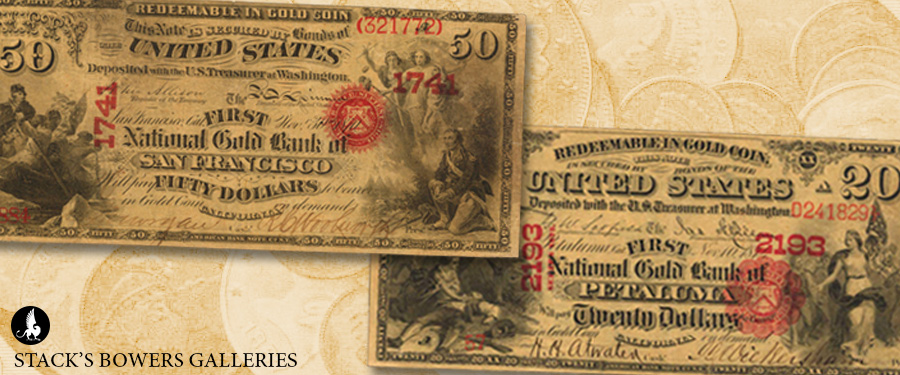
In the western United States, specifically California, hard money remained the norm in commerce, even after paper money had become more acceptable in the East and Midwest. Silver and gold were king, and other forms of currency that circulated in the East found no welcome in California. Distrust among the early pioneers that came seeking their fortunes in the gold fields of California directly influenced the prohibition of banks and other institutions from issuing paper money in the state.
However, in 1870 a compromise was made at the federal level, one that reflected the hard money preferences of California and the West Coast. The Currency Act of July 12, 1870, authorized the creation of special National Gold Banks that had the authority to issue National Bank Notes redeemable in gold coin. From 1871 through 1883 a total face value of $3,465,240 across almost 200,000 notes was issued to 10 banks in California and Massachusetts.
Issued in denominations of $5 through $500, these notes reflected their counterparts that were backed by bonds but differed notably in an aesthetic sense. Printed on bright orange-hued paper (with some exceptions) and bearing a shared vignette that illustrates a collage of gold coins against a gold-hued reverse, these notes were strikingly distinctive.
Nine banks in California would be chartered under the program. The largest of these, the First National Gold Bank of San Francisco, accounts for the majority of surviving notes today, while a scattering of notes are recorded on the remaining charters. $50s & $100s are practically non-existent and these attract significant attention when one crosses the auction block or appears for sale. In 2018 we sold the finest known $50 National Gold Bank Note, an Fr. 1160 from the Joel R. Anderson Collection for $384,000.
Across the country in Massachusetts, the Kidder National Gold Bank of Boston never issued any notes for circulation, and thus likely returned them to the Treasury where they were redeemed and later destroyed. A pair of specimens are known, but these are radically different aesthetically from their California counterparts on account of the bright gold tint and the banner “National Gold Note” displayed across the top margin. As these were just specimens, however, the true appearance of an example from the Kidder National Gold Bank remains unknown.
Today such notes are rare in any condition and are fiercely pursued by collectors. With just under 600 examples known across all denominations, the vast majority of survivors are below the grade of Very Fine or suffer from impairments. Even impaired examples bring strong bids, a fact that speaks to the popularity of this California oddity.
To consign your numismatic items to one of our upcoming auctions, please call 800-458-4646 or email [email protected].





